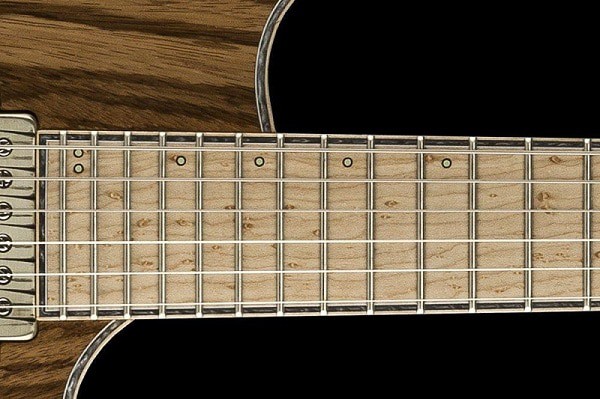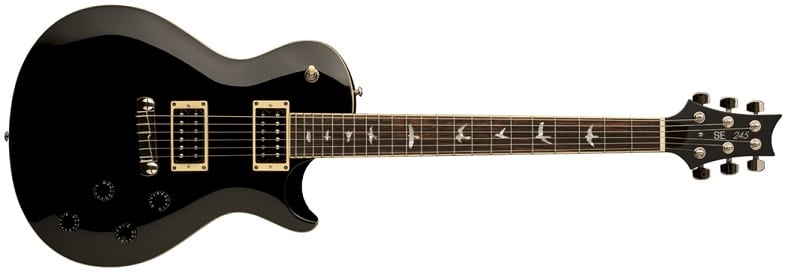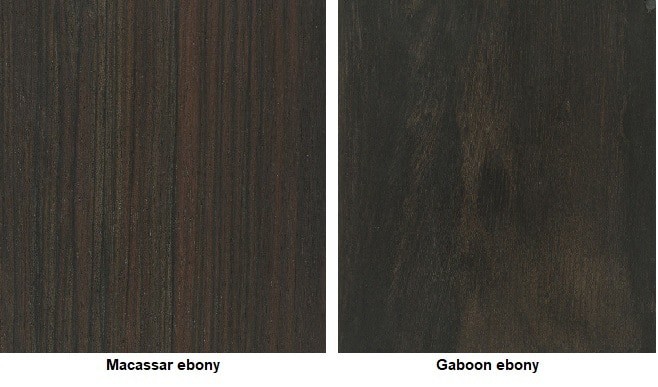One of most commonly overlooked features when purchasing a guitar, particularly by novices, is the type of fretboard material used. While the fretboard wood type has little direct impact overall on the tone of a solid body electric guitar, it does play a part in the feel and playability of the instrument, which by extension does play a significant role in the final tone.
This is important because a guitar’s playability plays a big part in the enjoyment you get out of playing the guitar. How you interact with the fretboard is the most important aspect of playing. If you don’t feel comfortable and in control, you won’t derive as much enjoyment from the process.
1. Types Of Wood
Over the years, a wide variety of wood types have been employed by guitar builders for both utilitarian and design reasons. For the most part, the woods that have come into common use in guitar construction even today have been hand down through the centuries by craftsmen who chose those woods for the way they shaped an acoustic instrument’s tone.
For this reason, they are often called “tonewoods”. Once solid body electrics came into being, the need for using tonewood ceased to be an issue as electro-magnetic pickups and electronics now fulfill the function that once belonged to the soundbox.
These days, some boutique guitar builders are employing exotic woods from around the world such as pau ferro, purple heart, bubinga and cocobolo, but, for the purposes of this article, we’ll stick to the types of wood used by the biggest and most established manufacturers – those that you’re likely to find online or at your local music store. These are still the tonewoods of old that have become standard in the industry.

2. A Word About Tonewood
There is a considerable debate surrounding the value of tonewood in solid body electric guitars. In 30+ years as a guitar player and builder, I can say with absolute certainty that there is nothing special about tonewood in the construction of solid-bodied instruments.
There are no tonal differences inherent in the wood itself; however, there may be perceptible differences in how a maple fretboard affects how a piece of music is played as opposed to a rosewood or ebony fretboard. For example, when I play my Stratocaster, which has a maple fingerboard, I may subconsciously use a lighter touch because when I bend a string it will have a tendency to slip more and bend more than I want it to, so it’s more of a control thing. That may lend a barely noticeable difference to the tone because I’m not pressing down as much on the string. When I play my BC Rich with a rosewood fingerboard, I’m a little looser and can press down harder.
3. The Big Three
There are three commonly used types of wood amongst guitar manufacturers for fretboards: Maple, Rosewood and Ebony. Within each type (or genus) of wood are different species which may be used based on a number of criteria, which may include availability, price, workability and/or popularity amongst players.
3.1. Maple Fretboard
Maple is one of most popular types of wood for fretboards. It has a natural creamy white color and is used as the fretboard material in Fender’s standard Telecaster and Stratocaster models.

Hard & Soft Maple

There are typically two species of maple used in creating maple fretboards: hard maple and silver maple. Hard maple, as the name implies, is harder and heavier than soft maple, however, that does not mean that silver maple (also called soft maple) is a softwood. In fact, both species of maple are quite hard, and make good fretboard material.
Hard maple is more expensive and more durable and tends to be found on the more well-known brands of guitars like Fender, Paul Reed Smith and Charvel, etc. Silver maple is more plentiful and less expensive as well as being easier to work. Some overseas manufacturers, particularly in China and Indonesia will use silver maple. This does not necessarily indicate a poorer quality of instrument. It still comes down to workmanship and how well put together an instrument is.
Hard Maple Grain Figuring
Within the hard maple species there are different types of grain figuring which can be used to enhance the appearance of an instrument. The most common patterns are quilted, curly/tiger/flame, birdseye and spalted.

Typically these are not seen in fretboard construction because these grain patterns are notoriously difficult to work with. Milling pieces of wood with swirling or wavy grain tends to cause “tearout”, a phenomenon where the blades of woodworking tools grab the fibers of the wood and literally tear the wood apart.
Extremely sharp tools are required to work with unusual grain patterns and mass production does not lend itself to such precise tool maintenance requirements. The closeup image of a Mayones Regius V-24 Zebrano shown beside is an excellent example of birdseye maple used on a fretboard.

Feel And Playability
It’s important to understand that due to the porous nature of the wood, maple is normally sealed with a lacquer or nitrocellulose finish. As a result, playing a guitar with a maple fretboard essentially means that you are playing the finish covering the wood rather than the wood itself. Depending upon the type and quality of finish, it can feel anywhere from slick and fast to sticky and slow.
Some musicians, like Swedish metal guitarist Yngwie Malmsteen for example, don’t like the feel of any finish at all on their fretboard, and will have the finish removed from the fretboards of their guitars before using them. This is effective, but necessitates more intensive maintenance and eventually more frequent replacement.
There is no one style of music that is more or less suitable for players who choose maple fretboards, and it all comes down to what the player him or herself is comfortable with.
Maintenance
Normal maintenance for a finished maple neck entails nothing more than wiping it down with dry cloth every few hours of play. Giving it a once over with a damp cloth with a little dish soap every couple of weeks is effective in removing any residual grime and oils left by your skin. Make sure that the neck is dry before storing it away!
An unfinished maple fretboard will require more frequent cleaning and conditioning depending upon how often it is played. Like with a finished maple fretboard, you should wipe it down with a dry cloth every few hours, but every month or two you should give it a good cleaning using 0000 steel wool to remove the “gunk”. Then use a cloth dipped in tung oil finish to polish the surface.
- Ease of maintenance (for finished fretboards)
- Slick feel makes it easier to play fast
- Depending upon manufacturer, can choose from different grain patterns and figuring
- Lighter color wood provides dramatic contrast in appearance with darker colored bodies
- More complex maintenance requirements (for unfinished fretboards)
- Slickness of fingerboard makes it more difficult to control string bending
3.2. Rosewood Fretboard
Rosewood has been used in stringed instruments for centuries, not only as a fretboard wood, but also as the sides and backs of violins, mandolins and lutes. Rosewood is instantly recognizable by its dark reddish-brown color. Depending on the species, that basic color can range from very dark, almost black, to deep mahogany red or espresso brown. Rosewood is used extensively in Gibson, Ibanez and Paul Reed Smith guitars to name just a few.

Types Of Rosewood

The most commonly used species of rosewood are: Brazilian, Honduran and Indian.
Brazilian rosewood is especially prized for its deep, rich color; however, it is highly endangered and a number of restrictions are placed on its sale. As a consequence, it is rare to find any mass produced guitars of recent manufacture using Brazilian rosewood.
Honduran rosewood has a similar grain pattern but is usually lighter in color. As a result, many fretboards made of Honduran rosewood are stained darker to more closely resemble Brazilian rosewood. Honduran rosewood is also becoming more endangered, but does not yet face the same restrictions on trade as the Brazilian rosewood does. Many manufacturers are switching, or have already switched to Indian rosewood which is less expensive and more plentiful.

Feel And Playability
Rosewood, regardless of the species is an open grained wood, and as such has a less slick feeling as opposed to maple. The stings tend to have more “bite”, theoretically giving a player more control, particularly when bending strings. Blues musicians and other guitarists who employ a lot of string bending such as Joe Bonamassa, Stevie Ray Vaughan and Steve Vai all tend to prefer rosewood fretboards.
Even guitar legend Eddie Van Halen, who early in his career played guitars that almost exclusively featured maple fretboards, is now frequently seen playing his signature model guitars with rosewood fingerboards.
Maintenance
The procedure for maintaining a rosewood fretboard is similar to that of maintaining a maple one, regularly wiping it down with a dry cloth every few hours.
It’s important to note that because of rosewood’s darker color, it’s harder to see when a significant amount of grime has built up requiring a more thorough cleaning. It is, therefore, essential that players take the time to take a close look at the fretboard every couple of weeks to make sure that there is no excessive buildup of oils or grime.
The basic techniques for cleaning and conditioning a rosewood fretboard are very similar to those used for a maple fretboard. Here for an excellent video on specific instructions for cleaning a rosewood fretboard.
- Ease of maintenance
- Strings bite into wood easier giving the player more control, particularly when bending strings
- Nice color and texture
- Brazilian rosewood is endangered and some companies violate restrictions to purchase illegal rosewood.
- Harder to tell when fretboard is dirty and needs more thorough cleaning.
3.3. Ebony Fretboard
There is perhaps no wood more prized for its beauty and utility in fretboard construction than ebony. Its deep black color, durability and smooth texture make it the perfect material for this application. Unfortunately, it’s this very beauty and durability is what has driven up demand for the wood and driven ebony trees to the brink of extinction.
Types Of Ebony

There are two types of ebony traditionally used in fretboard construction: Maccasar and Gaboon or African ebony. Macassar ebony comes from Southeast Asia and while it not listed in the CITES Appendices which lists highly endangered wood species, it is on the IUCN Red List as a vulnerable species due to a population reduction of over 20% in the past three generations.
Gaboon ebony is highly endangered and is listed in both the CITES Appendices and is on the IUCN Red List. It is listed as endangered due to a population reduction of over 50% in the past three generations. Due to the fact that ebony is a very slow growing tree, taking decades to reach full maturity it is not high on the sustainability index.
Both types of ebony have a remarkably similar appearance and color, although the grain pattern on Gaboon ebony tends to be more variable that that of Macassar ebony.
Due to the trade restrictions and low availability of ebony, guitars with ebony fretboards are increasingly rare and typically more expensive than those with maple or rosewood fretboards. Of these, almost all of them are Macassar ebony as purchase of Gaboon/African ebony has become nearly impossible. In 2011, the Gibson Guitar Corporation in Nashville was raided by the U.S. Justice Department for being in possession of a considerable number of African ebony fretboard blanks from Madagascar in violation of trade laws.
It’s easy to see from the images below the distinctive color or ebony as opposed to rosewood. The ebony is darker, almost black, while the rosewoods shows a dark red tint.

Feel And Playability
Ebony, is less open grained than rosewood, but still allows the stings tend to bite more than maple. Ebony is often preferred by traditionalists and is one of the reasons that vintage guitars are so treasured by collectors. Some people swear that they can tell just by listening that a certain guitar has an ebony fretboard.
My personal experience is that an ebony fingerboard is a nice middle ground between maple and rosewood in terms of playability. The action feels fast and slick, but I don’t encounter any slipperiness when bending strings.
One note of importance is that ebony is a naturally oily wood and there have been rare cases of people experiencing an allergic skin reaction to the oils in ebony wood. It’s important to keep this in mind if you are thinking about purchasing an instrument with an ebony fretboard and keep an eye out for any potential reaction.
Maintenance
Due to the woods natural durability and oily nature, the procedure for maintaining an ebony fretboard is actually very simple. Wipe the fretboard down thoroughly with a clean, lint-free cloth after playing. I
t does pay to apply an acid free oil such as MusicNomad F-One oil or Minwax Tung oil every couple of months. Here is an excellent video on specific instructions for conditioning an ebony fretboard.
- Ease of maintenance
- Fast action
- Good bite for control on string bending
- Beautiful appearance
- Ebony is an endangered species and some companies violate restrictions to purchase illegal ebony.
The Final Comparison Table
In the final analysis, it’s completely up to the individual what feels best to him or her. There is no right answer or claim that one wood type is “better” than the other.
On a personal level, I have played all three and don’t have favorite. Other factors such as the neck thickness and scale length are more important to me, and I’ll live with whatever the fretboard material is provided I like the neck length and profile. My current collection includes two guitars with rosewood fretboards and one with a maple fretboard, and I don’t have a favorite based on that criteria.
| Types | Maple | Rosewood | Ebony |
| Overview | – Has a clear les paul-ish tone, but it wears away giving it a dirty old look.
– Most popular fret-board wood. – Natural creamy white. – Used by Fender’s Telecaster & Stratocaster. |
– Receives a warmer tone, but is hard to bend
– Popular use for various stringed instruments. – Dark reddish-brown color. – Used by Gibson, Ibanez, PRS. |
– Gives a bight and shaky, snappy metal sound, but it can crack with the weather if not maintained with guitar oil and maintenance.
– Most beautiful… – Deep black color, durable, smooth texture. – High demand drives it to the brink of extinction. |
| Love | – Maintenance (finished fret-board).
– High speed shredding. – Various grain patterns and figuring. |
– Maintenance.
– Color and texture. – Strings bending is just a breeze. |
– Maintenance.
– No slipperiness when bending strings. – Fall in love with its beauty. |
| Unexpected | – Tired of maintenance (unfinished fret-board).
– Right note bending is hard. |
– Need of thorough cleaning. – Brazilian rosewood is at the brink of extinction. |
– Endangered species and some companies violate restrictions to purchase illegal ebony. |